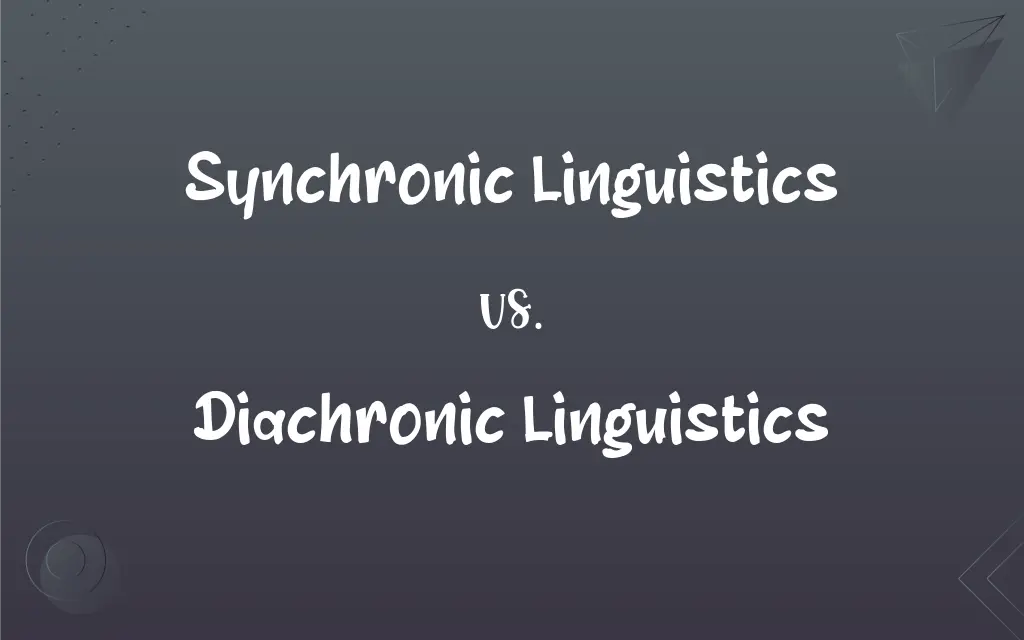Synchronic Linguistics vs. Diachronic Linguistics: What's the Difference?
Edited by Aimie Carlson || By Harlon Moss || Published on February 21, 2024
Synchronic linguistics studies language at a specific point in time, while diachronic linguistics examines how language evolves over time.

Key Differences
Synchronic linguistics focuses on analyzing the structure and usage of a language at a particular moment, treating it as a static system. It examines elements like grammar, syntax, and semantics as they exist in the present, disregarding historical context. Diachronic linguistics, in contrast, is concerned with the evolution and historical changes in a language. It traces developments in phonetics, grammar, and vocabulary over different time periods, seeking to understand the processes and reasons behind linguistic shifts.
In synchronic linguistics, linguists might study how different social groups use language today, examining variations in dialect, slang, or professional jargon. This approach treats language as a snapshot, frozen in time. Diachronic linguistics, on the other hand, would look at how these forms of speech have developed, tracing their origins and transformations. For instance, it might explore how Old English evolved into Modern English, focusing on shifts in phonology, lexicon, and syntax.
Synchronic linguistics is useful for understanding how a language functions in its contemporary form, providing insights into current linguistic norms and usage patterns. It is especially relevant in applied fields like language teaching, where current language structure is crucial. Conversely, diachronic linguistics offers a historical perspective, showing how languages are dynamic and evolve, influenced by social, cultural, and political changes. This is essential for historical linguistics and for understanding the roots and relationships among languages.
In synchronic linguistics, analysis is independent of time. A linguist might compare different languages or dialects as they are spoken today, without considering their historical development. Diachronic linguistics requires a longitudinal perspective, examining a single language or language family over an extended period, often involving the study of old texts and comparative linguistics to trace language evolution.
Synchronic linguistics often uses contemporary data, such as current speech patterns or written texts, to understand how a language operates. It can involve fieldwork, surveys, and corpus analysis. Diachronic linguistics relies heavily on historical documents, etymological studies, and comparative analysis of different language stages, requiring a deep understanding of historical contexts and language evolution processes.
ADVERTISEMENT
Comparison Chart
Focus
Studies language at a specific time
Examines language evolution over time
Method
Analyzes current language use and structure
Traces historical changes in language
Purpose
Understands language in its present form
Understands how and why language changes
Data Used
Current speech, writing, and usage patterns
Historical texts, etymological studies
Application
Useful in language teaching, sociolinguistics
Important for historical linguistics, language history
ADVERTISEMENT
Synchronic Linguistics and Diachronic Linguistics Definitions
Synchronic Linguistics
Analyzing language structure and usage at a specific moment.
Synchronic analysis reveals the diverse slang used by teenagers today.
Diachronic Linguistics
Understanding the reasons and processes behind linguistic shifts.
Diachronic linguistics explores how French influenced English after the Norman Conquest.
Synchronic Linguistics
Examining contemporary language variations without historical context.
A synchronic study showed how regional accents affect pronunciation.
Diachronic Linguistics
Investigating the historical development and evolution of a language.
Diachronic linguistics traces the transformation from Old to Modern English.
Synchronic Linguistics
Comparing different languages or dialects as they are currently spoken.
Synchronic linguistics contrasts American and British English usage.
Diachronic Linguistics
Tracing the historical transformations in syntax, vocabulary, and phonetics.
Diachronic studies explain the simplification of English grammar since the Middle Ages.
Synchronic Linguistics
Studying language as a static system at a particular time.
The synchronic approach analyzes grammar rules in current English.
Diachronic Linguistics
Focusing on how linguistic elements evolve over time.
Diachronic linguistics examines the phonetic shifts in the German language.
Synchronic Linguistics
Focusing on current linguistic norms and patterns.
Synchronic linguistics helps in understanding modern communication styles.
Diachronic Linguistics
Studying changes in language over different time periods.
Through diachronic analysis, the Latin roots of many English words are revealed.
FAQs
What is synchronic linguistics?
It's the study of a language's structure and usage at a specific point in time.
Do synchronic linguists consider historical language data?
No, they focus on current language data and treat language as a static system.
Can synchronic linguistics be applied in sociolinguistics?
Yes, it's useful for understanding current variations in language use across different social groups.
What's an example of a diachronic study?
Examining how English sentence structure has changed from the Elizabethan era to today.
What kind of data is used in diachronic linguistics?
Historical texts, old documents, and comparative studies of language stages.
How does diachronic linguistics contribute to historical linguistics?
By providing insights into language history and development.
What is an example of a synchronic study?
Analyzing the contemporary use of internet slang among different age groups.
How does diachronic linguistics differ from synchronic linguistics?
Diachronic linguistics focuses on the evolution and historical changes of language over time.
Can synchronic linguistics help in language teaching?
Yes, as it provides insights into the current structure and usage of a language.
Why is diachronic linguistics important?
It helps us understand how languages evolve and the reasons behind linguistic changes.
Does synchronic linguistics consider language change?
No, it analyzes language as a static entity without focusing on its change over time.
Can synchronic and diachronic linguistics be studied together?
Yes, combining both can provide a comprehensive understanding of language.
Is synchronic linguistics limited to spoken language?
No, it includes both spoken and written forms of language.
Does synchronic linguistics include comparative analysis?
Yes, but it compares languages or dialects at a specific point in time.
Can synchronic linguistics reveal regional language differences?
Yes, by analyzing language use in different regions at a certain time.
How does diachronic linguistics help in understanding modern language?
By showing the historical roots and evolutionary paths of contemporary language.
How do modern technologies impact synchronic linguistic studies?
They enable more extensive and detailed analysis of current language use and patterns.
How does diachronic linguistics explain language relationships?
By tracing the historical development and connections between languages.
What skills are needed for diachronic linguistic research?
Knowledge of historical contexts, language evolution, and etymological analysis.
What role does diachronic linguistics play in etymology?
It's crucial for understanding the origins and historical development of words.
About Author
Written by
Harlon MossHarlon is a seasoned quality moderator and accomplished content writer for Difference Wiki. An alumnus of the prestigious University of California, he earned his degree in Computer Science. Leveraging his academic background, Harlon brings a meticulous and informed perspective to his work, ensuring content accuracy and excellence.
Edited by
Aimie CarlsonAimie Carlson, holding a master's degree in English literature, is a fervent English language enthusiast. She lends her writing talents to Difference Wiki, a prominent website that specializes in comparisons, offering readers insightful analyses that both captivate and inform.







































































